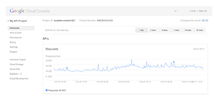Google Cloud Platform
|
| |
 | |
| Developer(s) | Google Inc. |
|---|---|
| Written in | |
| Platform | Google App Engine, Google Compute Engine, Google Cloud Storage, Google BigQuery |
| Type | Cloud Storage, Web Development |
| License | Proprietary |
| Website |
cloud |
Google Cloud Platform is a cloud computing platform by Google that offers hosting on the same supporting infrastructure that Google uses internally for end-user products like Google Search and YouTube.[1] Cloud Platform provides developer products to build a range of programs from simple websites to complex applications.[2][3]
Google Cloud Platform is a part of a suite of enterprise solutions from Google for Work and provides a set of modular cloud-based services with a host of development tools. For example hosting and computing, cloud storage, data storage, translations APIs and prediction APIs.[4]
Products
The Google Cloud Platform is composed of a family of products, each including a web interface, a command-line tool and a REST API.
- Google App Engine is a Platform as a Service for sandboxed web applications. App Engine offers automatic scaling with resources increased automatically to handle server load.
- Google Compute Engine is the Infrastructure as a Service component of the Google Cloud Platform that enables users to launch virtual machines (VMs) on demand.
- Google Cloud Storage is an online storage service for files.
- Google Cloud Datastore is a fully managed, highly available NoSQL data storage for non-relational data that includes a REST API.
- Google Cloud SQL is a fully managed MySQL database that lives in the Google Cloud infrastructure.
- Google BigQuery is a data analysis tool that uses SQL-like queries to process big datasets in seconds.
- Google Cloud Endpoints is a tool to create services inside App Engine that can be easily connected from iOS, Android and JavaScript clients.
- Google Cloud DNS is a DNS service hosted in the Google Cloud infrastructure.
Timeline
- Google App Engine was released as a preview in April 2008.[5]
- Google Cloud Storage launched May 2010 [6]
- On July 2012 Google creates the Google Cloud Platform Partner Program.[7]
- On October 2012, shortly after the Amazon outage, Google App Engine experienced a major outage that also affected Tumblr and Dropbox.[8]
- BigQuery was first presented in March and got into General Availability (GA) in April 2012.[9]
- After a 18-month preview on December 2013 Google Compute Engine was released GA.[10]
- Google Cloud SQL was released as GA on February 2014.[11]
- During the Google Cloud Platform Live event in March 2014 Google announced their biggest price drop affecting all products between a 30% and 85%.[12]
- On March 2014 Google announced Managed Virtual Machines, a new feature to overcome the traditional limitations in Google App Engine.[13]
See also
- Google Apps for Work
- Infrastructure as a Service
- Platform as a Service
- Heroku
- Amazon Web Services
- Windows Azure
- Jelastic
References
- ↑ "Why Google Cloud Platform". cloud.google.com. Retrieved 2014-04-05.
- ↑ "Google Cloud Platform". cloud.google.com. Retrieved 2014-04-05.
- ↑ "Google Cloud Products". cloud.google.com. Retrieved 2014-04-05.
- ↑ "Google Cloud Platform". cloud.google.com. Retrieved 2014-04-05.
- ↑ "Introducing Google App Engine + our new blog". Google Developer Blog. 2008-04-07. Retrieved 2014-04-05.
- ↑ http://techcrunch.com/2010/05/18/google-to-launch-amazon-s3-competitor-google-storage-at-io/
- ↑ "Introducing the Google Cloud Platform Partner Program: Helping businesses move to the cloud". Google Enterprise Blog. 2012-07-24. Retrieved 2014-04-05.
- ↑ "Whoopsie! Google App Engine goes down". GigaOM. 2012-10-26. Retrieved 2014-04-05.
- ↑ "Google opens up its BigQuery data analytics service to all". GigaOM. 2012-04-01. Retrieved 2014-04-05.
- ↑ "Google Compute Engine is now Generally Available with expanded OS support, transparent maintenance, and lower prices". Google Developers Blog. 2013-12-02. Retrieved 2014-04-05.
- ↑ "Google Cloud SQL now Generally Available with an SLA, 500GB databases, and encryption". Google Cloud Platform Blog. 2014-02-11. Retrieved 2014-04-05.
- ↑ "Google Cloud Platform Live - Blending IaaS and PaaS, Moore’s Law for the cloud". Google Cloud Platform Blog. 2014-03-25. Retrieved 2014-04-05.
- ↑ "Bringing together the best of PaaS and IaaS". Google Cloud Platform Blog. 2014-03-27. Retrieved 2014-04-05.
External links
| ||||||||||||||||||||||